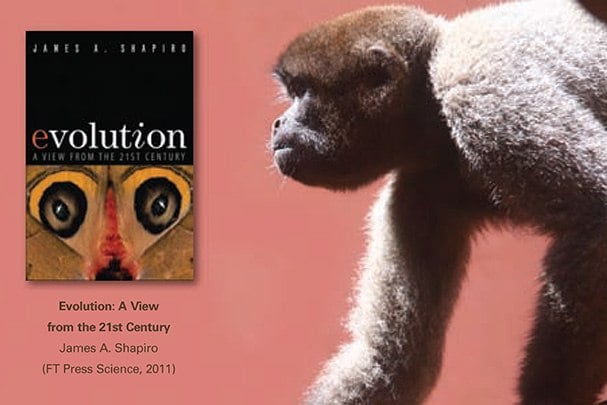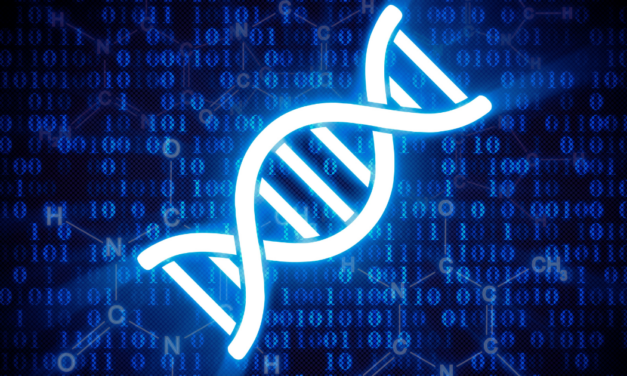This article first appeared in the CHRISTIAN RESEARCH JOURNAL, volume 35, number 01 (2012). The full text of this article in PDF format can be obtained by clicking here. For further information or to subscribe to the CHRISTIAN RESEARCH JOURNAL go to: http://www.equip.org/christian-research-journal/
A feature-length summary critique review of
Evolution: A View from the 21st Century
by James A. Shapiro
(FT Press Science, 2011)
Some heretics are burned at the stake. Others do quite well for themselves. In the history of Christianity, for instance, Giordano Bruno’s denial of the Trinity caused his temperature to rise considerably. A similar denial by Arius, on the other hand, left him largely unaffected. Indeed, orthodoxy’s champion Athanasius, Arius’s main rival, suffered five exiles to Arius’s one. Notwithstanding, history winnows heretics from the orthodox, so the good fortune of heretics in their own day counts for little in how history will ultimately regard them.
Fast forward to the present, where the reigning orthodoxy in the biological sciences is Darwinian evolution. James Shapiro, a molecular biologist at the University of Chicago, has just written a book that roundly rejects the Darwinian understanding of evolution: Evolution: A View from the 21st Century. Where Darwinism preaches gradualism, Shapiro preaches saltationism. Where Darwinism underscores natural selection acting on random variations, Shapiro underscores the ability of organisms to do their own “natural genetic engineering.” At times Shapiro writes like an ardent proponent of intelligent design (ID), but then at crucial points he veers off and just barely avoids heresy.
How does Shapiro stay in the good graces of the biological community despite his heterodox views? To answer this question, let’s get clearer about the form of evolution that Shapiro challenges. Down the hall from Shapiro at the University of Chicago is evolutionary geneticist Jerry Coyne. Writing online (“Don’t Know Much Biology,” June 6, 2007, www.edge.org), Coyne succinctly describes textbook orthodoxy regarding evolution:
There is only one going theory of evolution, and it is this: organisms evolved gradually over time and split into different species, and the main engine of evolutionary change was natural selection. Sure, some details of these processes are unsettled, but there is no argument among biologists about the main claims…While mutations occur by chance, natural selection, which builds complex bodies by saving the most adaptive mutations, emphatically does not. Like all species, man is a product of both chance and lawfulness.
Coyne here depicts the form of Darwinism that currently reigns, what is called the neo-Darwinian synthesis, which combines classical Darwinism (which holds to universal common ancestry, evolutionary gradualism, and natural selection) with modern genetic theory (which locates the source of heritable variation in genetic mutations, i.e., writing errors in DNA). Of all these elements, Shapiro only subscribes to one, namely, universal common ancestry, or common descent, the claim that all organisms trace their lineage to a common ancestor (thus making all organisms alive today cousins). On every other point, Shapiro demurs.
Thus, when it comes to the claim that evolution proceeds gradually, Shapiro writes (p. 89): “Do the sequences of contemporary genomes fit the predictions of change by ‘numerous, successive slight variations,’ as Darwin stated, or do they contain evidence of other, more abrupt processes…? The data are overwhelmingly in favor of the saltationist school that postulated major genomic changes at key moments in evolution.”
If Shapiro simply left matters there, however, he might align himself with proponents of punctuated equilibrium who, keeping faith as much as possible with neo-Darwinism, see the principal source of biological variation in genetic copying errors, otherwise known as “mutations.” But Shapiro rejects this view as well. For him, variation, which is always the creative potential of any evolutionary theory (no variation, no evolution), is not a random affair at all. Rather, organisms intelligently control their variation and thereby facilitate the evolutionary process. Shapiro writes (143): “Living cells and organisms are cognitive (sentient) entities that act and interact purposefully to ensure survival, growth, and proliferation. They possess corresponding sensory, communication, information-processing, and decision-making capabilities. Cells are built to evolve; they have the ability to alter their hereditary characteristics rapidly through well-described natural genetic engineering and epigenetic processes as well as cell mergers.”
Shapiro’s view of evolution is here concisely summarized. Organisms behave purposefully. They evolve themselves. They do this by intentionally modifying their own DNA. Within neo-Darwinism, DNA is a read-only memory subject to occasional copying errors. For Shapiro, DNA is a read-write memory, with the organism itself deciding when and where to modify its DNA.
Who’s right, the neo-Darwinists or Shapiro? The evidence is all on Shapiro’s side. The bulk of his book details biological system after system, showing the prevalence and pervasiveness of natural genetic engineering (organisms engineering their own DNA), epigenetics (organisms inducing heritable changes outside DNA control), and endosymbiosis (organisms merging with others). And if, per impossibile, the book itself doesn’t contain enough biological detail, Shapiro arranged with the publisher to set up a website providing still further evidence for his view (www.ftpress.com/shapiro).
The reason Darwinism was accepted at all, according to Shapiro, is that for its time it constituted a plausible simplification. Given the huge advances in molecular biology in recent decades, however, that simplification has now become an over- simplification. As Shapiro observes (128), “Molecular evidence about genome sequence changes tell us that the simplifying assumptions made in the 19th and early 20th Centuries are plainly wrong. They fail to account for the variety of cellular and genomic events we now know to have occurred.”
Even so, despite such deep-seated heresy against the reigning Darwinian view, Shapiro leads a charmed existence in the academy, calling down no rancor on his head and even eliciting high praise from some of the brightest in the scientific world. Indeed, the endorsements (blurbs) for his book are astonishing. My favorite, for its sheer obliviousness to irony, is by Nobel Prize–winning chemist Sidney Altman: “Shapiro has written a stimulating, innovative manuscript that surely Darwin would have liked.” That depends on whether Darwin would have liked to see his theory go up in flames.
One may wonder how Shapiro remains a member in good standing with the scientific community. Cells, according to Shapiro, are intelligently guiding their own evolution. Come again? This certainly isn’t Darwinism. Nor is it theistic evolution, with its view that God used Darwinian processes to effect evolution (see www.biologos.org). To be sure, it’s not creationism, with the view that God specially created organisms from scratch rather than from pre-existing organisms. But it certainly sounds close to ID. And yet there’s a crucial difference, one that Shapiro is able to exploit and that keeps him safe.
The difference between ID and Shapiro’s view is not that organisms evolved. ID is compatible with special creation, but it is also compatible with an evolutionary process under intelligent control in which the guidance given to evolution is extrinsic, substantive, and detectable. Design proponent Michael Behe, author of Darwin’s Black Box, holds such a view. And yet, whereas Behe’s biology department at Lehigh University ostracizes him (see the disclaimer cited on the biology homepage distancing the department from Behe’s views—www.lehigh.edu/bio), Shapiro remains a golden boy at the University of Chicago.
Shapiro manages to stay safe because he does not explicitly challenge the naturalism that underlies Darwinian orthodoxy. Behe sees an intelligence extrinsic to the material forces of nature as requisite for life’s origin and subsequent evolutionary history. Shapiro doesn’t. For Behe, the genetic engineer is a designing intelligence external to the organism. For Shapiro, the genetic engineer is the cell itself, doing its own natural genetic engineering. Cells that do their own natural genetic engineering mount no greater challenge to a naturalistic worldview than humans that engineer the various technologies we enjoy. In both cases, natural entities endowed with teleological powers (in the one case, cells facilitating their biological evolution, in the other, humans facilitating their cultural evolution) are pursuing their natural ends.
And yet, Shapiro has set evolutionary theory on a precipice. I’ve known and corresponded (very intermittently) with Shapiro over a decade now, and the views expressed in his recent book are those he has held and written about throughout that time. In 2002 he was kind enough to do an online chat on biological evolution (www.iscid.org/james-shapiro-chat.php). In that chat, I posed the following question:
James, we met the first time at Wheaton College at a symposium in the spring of 1997 featuring principally you and Michael Behe along with Paul Nelson and David Hull. At the time, I asked you about the origin of such “natural genetic engineering” systems. As I recall, you indicated that this was not really the problem you were addressing. Have you thought any more about this problem? Specifically, how do such systems arise that can take over their evolution? And how much complexity do they require? Are you confident that nonteleological mechanisms can account for the rise of natural genetic engineering systems, and if so why?
Shapiro’s reply was illuminating for what it failed to say: “I am not sure how to answer your question. All existing living organisms possess natural genetic engineering capabilities. So they must be pretty fundamental. Any self-organizing evolving system has to have the capacity to alter its information store. That’s what they do. Where they come from in the first place is not a question we can realistically answer now, any more than we can explain the origin of the first cells.”
In his book, Shapiro likewise admits that he has no answer to this question. And yet, this is the million-dollar question. Organisms that can do their own natural genetic engineering are themselves marvels of engineering. We need to be engineers even to understand them. Moreover, the engineering feats they accomplish vastly overshadow human technological prowess. So why should it be a stretch to think that such systems are themselves the result of engineering? But in that case, who or what is the engineer? Since biological life itself, in all forms that we know, presupposes natural genetic engineering, its source cannot be biological (unless we’re willing to countenance radically simpler and different biological forms that are unexampled and, for now, exist merely in our imaginations). The intelligence would thus have to be extrinsic to life, which would make life the product of ID.
Of course, Shapiro won’t go there, and as long as he doesn’t, he can stay within the bounds of scientific orthodoxy, though just barely. And yet the logic of his position leads directly to ID. When future generations consider the impact of his ideas, they will not see him as a valiant defender of naturalism against the onslaughts of ID. Rather, they will see him as one who set biology on a slippery slope, opened the city gates, and gave away the store (to mix metaphors with gusto).
As for the book itself, I highly recommend it. Most of it is quite technical and will be beyond anyone without a strong background in biology. But Shapiro punctuates the book with moments of candor and lucidity that are always refreshing. The book has a helpful glossary and the final chapter (he calls them “parts”) is very readable and provides a nice overview of his project.
William A. Dembski, Ph.D., is the author or editor of more than twenty books, including The Design of Life: Discovering Signs of Intelligence in Biological Systems (Foundation for Thought and Ethics, 2008).









